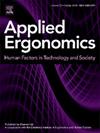Evaluation of the support provided by a soft passive exoskeleton in individuals with back pain
IF 3.4
2区 工程技术
Q2 ENGINEERING, INDUSTRIAL
引用次数: 0
Abstract
Physically straining occupations involving repetitive lifting and forward leaning increase risk of back pain. In response, back exoskeletons have been developed to alleviate strain on back muscles and potentially prevent such pain. In people experiencing back pain, these may also help decrease the pain-related activity limitations during work or leisure.
This experimental study evaluated the effects of a soft passive back exoskeleton on muscle activity, acute pain, kinesiophobia, and movement kinematics. Individuals experiencing mild to moderate back pain (n = 35) performed forward leaning and lifting tasks, both with and without the support of the back exoskeleton. Electromyography data were collected for trunk and hip muscles, alongside hip and spine kinematics, reported pain levels and concerns regarding daily activities.
Back exoskeleton support reduced back muscle activity during forward leaning by up to 35% (pExo < 0.001) and during lifting tasks by up to 24% (pExo < 0.001). Participants reported reduced lumbar pain (p < 0.01) and decreased kinesiophobia (p < 0.001) across all tasks when supported by the exoskeleton. Minimal influence on movement kinematics was observed and there were no observable changes in abdominal co-activation compared to tasks performed without exoskeleton support. These results indicate that the LiftSuit, a passive back exoskeleton, can effectively reduce back muscle activity, acute pain, and kinesiophobia among individuals with back pain during forward leaning and repetitive lifting tasks. These findings suggest that passive back exoskeletons may be beneficial during physically demanding tasks in workers experiencing mild to moderate back pain.

评估软性被动外骨骼对背痛患者的支持作用
体力紧张的工作包括重复性的举起和前倾会增加背部疼痛的风险。作为回应,背部外骨骼已经被开发出来,以减轻背部肌肉的压力,并有可能预防这种疼痛。对于正在经历背部疼痛的人,这些也可能有助于减少工作或休闲期间与疼痛相关的活动限制。本实验研究评估了软性被动背部外骨骼对肌肉活动、急性疼痛、运动恐惧症和运动运动学的影响。有轻度至中度背部疼痛的个体(n = 35)在有或没有背部外骨骼支持的情况下进行前倾和举重任务。收集躯干和臀部肌肉的肌电图数据,以及髋关节和脊柱的运动学数据,报告的疼痛程度和对日常活动的关注。背部外骨骼支持可减少前倾时背部肌肉活动高达35% (pExo <;0.001),而在起重任务中,高达24% (pExo <;0.001)。参与者报告腰痛减轻(p <;0.01),运动恐惧症减少(p <;0.001),在外骨骼的支持下完成所有任务。与没有外骨骼支持的任务相比,观察到对运动运动学的影响最小,腹部共同激活没有明显的变化。这些结果表明,LiftSuit,一种被动式背部外骨骼,可以有效地减少背部肌肉活动,急性疼痛,以及在前倾和重复性举重任务中背部疼痛的个体的运动恐惧症。这些研究结果表明,被动背部外骨骼可能对患有轻度至中度背部疼痛的工人在体力要求高的任务中有益。
本文章由计算机程序翻译,如有差异,请以英文原文为准。
求助全文
约1分钟内获得全文
求助全文
来源期刊

Applied Ergonomics
工程技术-工程:工业
CiteScore
7.50
自引率
9.40%
发文量
248
审稿时长
53 days
期刊介绍:
Applied Ergonomics is aimed at ergonomists and all those interested in applying ergonomics/human factors in the design, planning and management of technical and social systems at work or leisure. Readership is truly international with subscribers in over 50 countries. Professionals for whom Applied Ergonomics is of interest include: ergonomists, designers, industrial engineers, health and safety specialists, systems engineers, design engineers, organizational psychologists, occupational health specialists and human-computer interaction specialists.
 求助内容:
求助内容: 应助结果提醒方式:
应助结果提醒方式:


